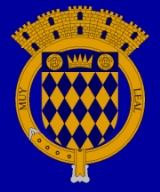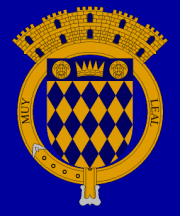
Arasibo
Encyclopedia
Arasibo was a Taino
Cacique
in Puerto Rico
who governed the area which is now named after him (now spelled Arecibo
).

whose village was located by the shore of the river "Abacoa" (now known as the "Río Grande de Arecibo
"). Arasibo had been known to be a "just" and respected cacique and his tribe had led a peaceful existence before the arrival of the Spaniards. The rivers close to the village were full of fish and turtles and so it was only natural that the members of Arasibo's tribe were fishermen. Their land produced many fruits, such as papaya
s; the tribe were cultivators of corn. Arasibo loved to collect all kinds of animals and birds. He, like the rest of the other Caciques, reported only to the "Supreme Cacique" Agüeybaná
.
(The Brave), discovered that the Spaniards were not "god
s" and this encouraged the Cacique to rebel against the invaders. The rebellion failed after Juan Ponce de Leon
's troops confronted and killed
Agüeybaná II.
, Toste states that his research and investigations led him to uncover the following facts. In the year 1515, all of the area of Arecibo including the rivers of "Rio Grande" and "Tanama" were given as a gift to a Lope Conchillos
(who resided in Spain) by the Spanish Crown. Conchillos sent a helper by the name of "Pedro Moreno" to the island to administer his lands; Moreno found Arasibo and his tribe of about 200 Tainos living in the land; he then enslaved them and Arasibo and his people died shortly after.
of the City of Arecibo represents the glory of the Cacique Arasibo, who was the first known ruler of the region.
Taíno people
The Taínos were pre-Columbian inhabitants of the Bahamas, Greater Antilles, and the northern Lesser Antilles. It is thought that the seafaring Taínos are relatives of the Arawak people of South America...
Cacique
Cacique
Cacique is a title derived from the Taíno word for the pre-Columbian chiefs or leaders of tribes in the Bahamas, Greater Antilles, and the northern Lesser Antilles...
in Puerto Rico
Puerto Rico
Puerto Rico , officially the Commonwealth of Puerto Rico , is an unincorporated territory of the United States, located in the northeastern Caribbean, east of the Dominican Republic and west of both the United States Virgin Islands and the British Virgin Islands.Puerto Rico comprises an...
who governed the area which is now named after him (now spelled Arecibo
Arecibo, Puerto Rico
Arecibo is a municipality in the northern midwest coast of Puerto Rico and located by the Atlantic Ocean, north of Utuado and Ciales; east of Hatillo; and west of Barceloneta, and Florida. Arecibo is spread over 18 wards and Arecibo Pueblo...
).

Pre-Columbian era
Arasibo governed a tribeTribe
A tribe, viewed historically or developmentally, consists of a social group existing before the development of, or outside of, states.Many anthropologists use the term tribal society to refer to societies organized largely on the basis of kinship, especially corporate descent groups .Some theorists...
whose village was located by the shore of the river "Abacoa" (now known as the "Río Grande de Arecibo
Río Grande de Arecibo
The Río Grande de Arecibo is a river of Puerto Rico. The headwaters lie in the mountains to the south of Adjuntas. From there it flows north until it reaches the Atlantic Ocean near Arecibo. The tributaries lie along the side of the Cerro de Punta and the Utuado pluton...
"). Arasibo had been known to be a "just" and respected cacique and his tribe had led a peaceful existence before the arrival of the Spaniards. The rivers close to the village were full of fish and turtles and so it was only natural that the members of Arasibo's tribe were fishermen. Their land produced many fruits, such as papaya
Papaya
The papaya , papaw, or pawpaw is the fruit of the plant Carica papaya, the sole species in the genus Carica of the plant family Caricaceae...
s; the tribe were cultivators of corn. Arasibo loved to collect all kinds of animals and birds. He, like the rest of the other Caciques, reported only to the "Supreme Cacique" Agüeybaná
Agüeybaná
Agüeybaná and Agüeybaná II , were the principal and most powerful caciques of the Taíno people in "Borikén" when the Spaniards first arrived on the island on November 19, 1493.- "The Great Sun" :...
.
Arrival of the Conquistadors
The relationship between the Spaniards and the Tainos was peaceful at first, however, all that changed when the Conquistadores started to enslave the natives. In 1511, Agueybana's nephew Güeybaná, better known as Agüeybaná IIAgüeybaná
Agüeybaná and Agüeybaná II , were the principal and most powerful caciques of the Taíno people in "Borikén" when the Spaniards first arrived on the island on November 19, 1493.- "The Great Sun" :...
(The Brave), discovered that the Spaniards were not "god
God
God is the English name given to a singular being in theistic and deistic religions who is either the sole deity in monotheism, or a single deity in polytheism....
s" and this encouraged the Cacique to rebel against the invaders. The rebellion failed after Juan Ponce de Leon
Juan Ponce de León
Juan Ponce de León was a Spanish explorer. He became the first Governor of Puerto Rico by appointment of the Spanish crown. He led the first European expedition to Florida, which he named...
's troops confronted and killed
Murder
Murder is the unlawful killing, with malice aforethought, of another human being, and generally this state of mind distinguishes murder from other forms of unlawful homicide...
Agüeybaná II.
Cronicals of Arecibo
In the Cronicals of Arecibo written by Puerto Rican historian Cayetano Coll y TosteCayetano Coll y Toste
Dr. Cayetano Coll y Toste , was a Puerto Rican historian and writer. He was the patriach of a prominent family of Puerto Rican, educators, politicians and writers.-Early years:...
, Toste states that his research and investigations led him to uncover the following facts. In the year 1515, all of the area of Arecibo including the rivers of "Rio Grande" and "Tanama" were given as a gift to a Lope Conchillos
Lope Conchillos y Quintana
Lope Conchillos y Quintana was a Spanish politician, and secretary at the court of King Ferdinand "the Catholic". He was of Converso Jewish heritage and married María Niño de Ribera, cousin of the Duke of Infantado. He was awarded an encomienda in Arasibo in Puerto Rico...
(who resided in Spain) by the Spanish Crown. Conchillos sent a helper by the name of "Pedro Moreno" to the island to administer his lands; Moreno found Arasibo and his tribe of about 200 Tainos living in the land; he then enslaved them and Arasibo and his people died shortly after.
Legacy
The crown in the coat of armsCoat of arms
A coat of arms is a unique heraldic design on a shield or escutcheon or on a surcoat or tabard used to cover and protect armour and to identify the wearer. Thus the term is often stated as "coat-armour", because it was anciently displayed on the front of a coat of cloth...
of the City of Arecibo represents the glory of the Cacique Arasibo, who was the first known ruler of the region.
See also
- List of famous Puerto Ricans
- List of Tainos
- Agüeybaná and Agüeybaná II
- HayuyaHayuyaHayuya was the Taino Cacique who governed the area in Puerto Rico which now bears his name .-Arrival of the Conquistadors:...
- JumacaoJumacaoJumacao a.k.a. Jumaca was the Taíno Cacique of the area in Puerto Rico named after him .-Before and after the arrival of the Conquistadors:...
- OrocobixOrocobixOrocobix was the principal regional Taino Cacique of the central mountain region of Puerto Rico called Jatibonicu in the 16th century. The Jatibonicu territorial region covered the present day municipalities of Aibonito, Orocovis, Barranquitas, Morovis and Corozal...
- Tibes Indigenous Ceremonial CenterTibes Indigenous Ceremonial CenterThe Tibes Indigenous Ceremonial Center in Barrio Portugués, Ponce, Puerto Rico, houses one of the most important archeological discoveries made in the Antilles. The discovery provides an insight as to how the indigenous tribes of the Igneri and Taínos lived and played during and before the arrival...

